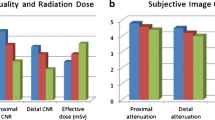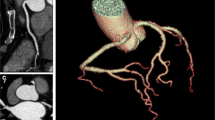Abstract
The accuracy of coronary computed tomography angiography (CCTA) in obese persons is compromised by increased image noise. We investigated CCTA image quality acquired on a high-definition 64-slice CT scanner using modern adaptive statistical iterative reconstruction (ASIR). Seventy overweight and obese patients (24 males; mean age 57 years, mean body mass index 33 kg/m2) were studied with clinically-indicated contrast enhanced CCTA. Thirty-five patients underwent a standard definition protocol with filtered backprojection reconstruction (SD-FBP) while 35 patients matched for gender, age, body mass index and coronary artery calcifications underwent a novel high definition protocol with ASIR (HD-ASIR). Segment by segment image quality was assessed using a four-point scale (1 = excellent, 2 = good, 3 = moderate, 4 = non-diagnostic) and revealed better scores for HD-ASIR compared to SD-FBP (1.5 ± 0.43 vs. 1.8 ± 0.48; p < 0.05). The smallest detectable vessel diameter was also improved, 1.0 ± 0.5 mm for HD-ASIR as compared to 1.4 ± 0.4 mm for SD-FBP (p < 0.001). Average vessel attenuation was higher for HD-ASIR (388.3 ± 109.6 versus 350.6 ± 90.3 Hounsfield Units, HU; p < 0.05), while image noise, signal-to-noise ratio and contrast-to noise ratio did not differ significantly between reconstruction protocols (p = NS). The estimated effective radiation doses were similar, 2.3 ± 0.1 and 2.5 ± 0.1 mSv (HD-ASIR vs. SD-ASIR respectively). Compared to a standard definition backprojection protocol (SD-FBP), a newer high definition scan protocol in combination with ASIR (HD-ASIR) incrementally improved image quality and visualization of distal coronary artery segments in overweight and obese individuals, without increasing image noise and radiation dose.







Similar content being viewed by others
References
Romero-Corral A, Montori VM, Somers VK, Korinek J, Thomas RJ, Allison TG et al (2006) Association of bodyweight with total mortality and with cardiovascular events in coronary artery disease: a systematic review of cohort studies. Lancet 368(9536):666–678
Yoshimura N, Sabir A, Kubo T, Lin PJ, Clouse ME, Hatabu H (2006) Correlation between image noise and body weight in coronary CTA with 16-row MDCT. Acad Radiol 13(3):324–328
Raff GL, Gallagher MJ, O’Neill WW, Goldstein JA (2005) Diagnostic accuracy of noninvasive coronary angiography using 64-slice spiral computed tomography. J Am Coll Cardiol 46(3):552–557
Chinnaiyan KM, McCullough PA, Flohr TG, Wegner JH, Raff GL (2009) Improved noninvasive coronary angiography in morbidly obese patients with dual-source computed tomography. J Cardiovasc Comput Tomog. 3(1):35–42
Silva AC, Lawder HJ, Hara A, Kujak J, Pavlicek W (2010) Innovations in CT dose reduction strategy: application of the adaptive statistical iterative reconstruction algorithm. AJR Am J Roentgenol 194(1):191–199
Leipsic J, Heilbron BG, Hague C (2012) Iterative reconstruction for coronary CT angiography: finding its way. Int J Cardiovasc Imaging 28(3):613–620
Leipsic J, Labounty TM, Heilbron B, Min JK, Mancini GB, Lin FY et al (2010) Estimated radiation dose reduction using adaptive statistical iterative reconstruction in coronary CT angiography: the ERASIR study. AJR Am J Roentgenol 195(3):655–660
Pontone G, Andreini D, Bartorelli AL, Bertella E, Mushtaq S, Foti C et al (2012) Feasibility and diagnostic accuracy of a low radiation exposure protocol for prospective ECG-triggering coronary MDCT angiography. Clin Radiol 67(3):207–215
Leipsic J, Labounty TM, Heilbron B, Min JK, Mancini GB, Lin FY et al (2010) Adaptive statistical iterative reconstruction: assessment of image noise and image quality in coronary CT angiography. AJR Am J Roentgenol 195(3):649–654
Kazakauskaite E, Husmann L, Stehli J, Fuchs T, Fiechter M, Klaeser B et al (2013) Image quality in low-dose coronary computed tomography angiography with a new high-definition CT scanner. Int J Cardiovasc Imaging 29(2):471–477
Desai GS, Uppot RN, Yu EW, Kambadakone AR, Sahani DV (2012) Impact of iterative reconstruction on image quality and radiation dose in multidetector CT of large body size adults. Eur Radiol 22(8):1631–1640
Ghadri JR, Kuest SM, Goetti R, Fiechter M, Pazhenkottil AP, Nkoulou RN et al (2011) Image quality and radiation dose comparison of prospectively triggered low-dose CCTA: 128-slice dual-source high-pitch spiral versus 64-slice single-source sequential acquisition. Int J Cardiovasc Imaging 28(5):1217–1225
Buechel RR, Husmann L, Herzog BA, Pazhenkottil AP, Nkoulou R, Ghadri JR et al (2011) Low-dose computed tomography coronary angiography with prospective electrocardiogram triggering: feasibility in a large population. J Am Coll Cardiol 57(3):332–336
Husmann L, Herzog BA, Gaemperli O, Tatsugami F, Burkhard N, Valenta I et al (2009) Diagnostic accuracy of computed tomography coronary angiography and evaluation of stress-only single-photon emission computed tomography/computed tomography hybrid imaging: comparison of prospective electrocardiogram-triggering vs. retrospective gating. Eur Heart J 30(5):600–607
Herzog BA, Husmann L, Burkhard N, Valenta I, Gaemperli O, Tatsugami F et al (2009) Low-dose CT coronary angiography using prospective ECG-triggering: impact of mean heart rate and heart rate variability on image quality. Acad Radiol 16(1):15–21
Raff GL, Goldstein JA (2007) Coronary angiography by computed tomography: coronary imaging evolves. J Am Coll Cardiol 49(18):1830–1833
McNulty PH, Ettinger SM, Field JM, Gilchrist IC, Kozak M, Chambers CE et al (2002) Cardiac catheterization in morbidly obese patients. Catheter Cardiovasc Interv 56(2):174–177
Leschka S, Stinn B, Schmid F, Schultes B, Thurnheer M, Baumueller S et al (2009) Dual source CT coronary angiography in severely obese patients: trading off temporal resolution and image noise. Invest Radiol 44(11):720–727
Kropil P, Rojas CA, Ghoshhajra B, Lanzman RS, Miese FR, Scherer A et al (2012) Prospectively ECG-triggered high-pitch spiral acquisition for cardiac CT angiography in routine clinical practice: initial results. J Thorac Imaging 27(3):194–201
Srichai MB, Lim RP, Donnino R, Mannelli L, Hiralal R, Avery R et al (2012) Low-dose, prospective triggered high-pitch spiral coronary computed tomography angiography: comparison with retrospective spiral technique. Acad Radiol 19(5):554–561
Paul NS, Kashani H, Odedra D, Ursani A, Ray C, Rogalla P (2011) The influence of chest wall tissue composition in determining image noise during cardiac CT. AJR Am J Roentgenol 197(6):1328–1334
Xu L, Zhang Z (2010) Coronary CT angiography with low radiation dose. Int J Cardiovasc Imaging 26(Suppl 1):17–25
Gebhard C, Fiechter M, Fuchs TA, Ghadri JR, Herzog BA, Kuhn F et al (2012) Coronary artery calcium scoring: influence of adaptive statistical iterative reconstruction using 64-MDCT. Int J Cardiol. doi:10.1016/j.ijcard.2012.08.003
Acknowledgments
The study was supported by grants from the Swiss National Science Foundation (SNSF) to P.A.K., C.G. and to M.F.
Ethical standard
All procedures followed were in accordance with the ethical standards of the responsible committee on human experimentation (institutional and national) and with the Helsinki Declaration of 1975, as revised in 2008. The need for written informed consent in this study was waived by the institutional review board (local ethics committee) since, according to Swiss law on clinical investigations, informed consent is not required if the nature of the study is purely retrospective.
Conflict of interest
The authors declare that they have no conflict of interest.
Author information
Authors and Affiliations
Corresponding author
Additional information
Cathérine Gebhard and Tobias A. Fuchs contributed equally to this work.
Rights and permissions
About this article
Cite this article
Gebhard, C., Fuchs, T.A., Fiechter, M. et al. Image quality of low-dose CCTA in obese patients: impact of high-definition computed tomography and adaptive statistical iterative reconstruction. Int J Cardiovasc Imaging 29, 1565–1574 (2013). https://doi.org/10.1007/s10554-013-0228-4
Received:
Accepted:
Published:
Issue Date:
DOI: https://doi.org/10.1007/s10554-013-0228-4




